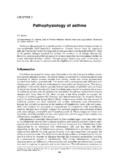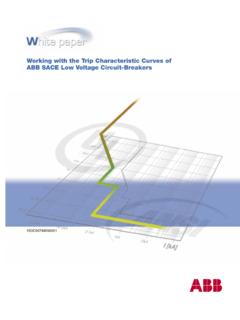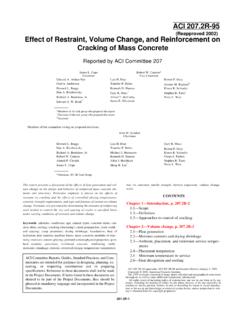Transcription of Pressure-Volume Curves of the Respiratory System
1 Pressure-Volume Curves of the Respiratory SystemR Scott Harris MDIntroductionEquation of MotionStatic Versus Dynamic Pressure-Volume CurvesStatic Compliance, Chord Compliance, Specific Compliance, and thePressure- volume CurveMeasurementSupersyringe MethodConstant-Flow MethodMultiple-Occlusion MethodPhysiologic MeaningLung Versus Chest WallSupine PostureHysteresisAlterations in Disease StatesObesityAcute Respiratory Distress SyndromeCongestive Heart FailureEmphysemaAsthmaInterstitial Lung DiseaseIntra-Abdominal HypertensionSummaryThe quasi-static Pressure-Volume (P-V) curve of the Respiratory System describes the mechanicalbehavior of the lungs and chest wall during inflation and deflation.
2 To eliminate resistive andconvective acceleration effects, the measurement of volume and pressure must be performed duringshort periods of apnea or during very slow flow. There are 3 main techniques for acquiringquasi-static P-V Curves : the supersyringe method, the constant flow method, and the multiple-occlusion (or ventilator) method. For the information to be interpreted correctly, one must under-stand the interaction between the lungs and the chest wall, the effects of the supine position, and themeaning of hysteresis. The P-V curve has been studied in many disease states, but it has beenapplied most extensively to patients with acute Respiratory distress syndrome, in hopes that it mightallow clinicians to customize ventilator settings according to a patient s individual respiratorymechanics and thus protect the patient from ventilator-induced lung injury.
3 However, lack ofstandardization of the procedure used to acquire P-V Curves , difficulties in measuring absolute lungvolume, lack of knowledge regarding how to use the information, and a paucity of data showing abenefit in morbidity and mortality with the use of P-V Curves have tempered early enthusiasmregarding the clinical usefulness of the quasi-static P-V words: lung mechanics, compli-ance, lung recruitment, Pressure-Volume curve, mechanical ventilation; acute Respiratory distress syn-drome; waveforms.[Respir Care 2005;50(1):78 98. 2005 Daedalus Enterprises]78 RESPIRATORYCARE JANUARY2005 VOL50 NO1 IntroductionIn spontaneously breathing subjects the diaphragm andchest wall together form a mechanical pump that movesair in and out of the lungs to exchange oxygen and carbondioxide to and from the blood.
4 When the Respiratory sys-tem fails and mechanical ventilation is necessary, the re-spiratory System s mechanical behavior can change in char-acteristic ways that can be assessed by the mechanicalventilator or with simple equipment available in respira-tory care departments. The quasi-static Pressure-Volume (P-V) relationship is one aspect of mechanical behaviorthat has been used to gain information about the way thelungs deform during breathing in health and has long been hoped that with mechanically ventilatedpatients the P-V curve would allow the clinician to diag-nose lung disease, customize ventilator settings, follow thecourse of disease, and make prognoses.
5 Surprisingly, de-spite over a half-century of research on P-V Curves , westill have a limited understanding of the meaning of theP-V relationship. So, though some of those goals havebeen realized, much research still needs to be done beforeP-V Curves can be widely used of MotionThe equation of motion describes the pressure change atthe airway opening during breathing. The equation as-sumes one degree of freedom, meaning that the lung ex-pands equally in all directions (isotropic expansion). It iswritten as:PAO VC V R V I Pmus(1)in which PAOis the pressure at the airway opening (mouthor endotracheal tube), Pmusis the pressure generated by therespiratory muscles, V is lung volume , C is Respiratory - System compliance, V is gas flow, R is airway resistance,V is convective gas acceleration, and I is impedance.
6 Whatis evident from that equation is that a static P-V curveeliminates the resistive and impedance effects on pressure,such that only the compliance is assessed. Thus, static P-Vcurves are also called compliance Curves . Also evident isthe Respiratory muscle contribution to pressure. If a subjectis not sufficiently sedated (or paralyzed), the measuredP-V curve may not be representative of the lung compli-ance properties alone and may include effects of the re-spiratory Versus Dynamic Pressure-Volume CurvesWhenever one measures pressure when airflow hasstopped, there is always a continual change in pressure lowering in an exponential fashion.
7 Because we must al-low the subject to breathe, the measurement must be in-terrupted after a few seconds. Therefore, the System neverreaches truly static conditions, so we obtain what has beencalled a quasi-static P-V curve. This means that theresultant curve depends somewhat on how long the clini-cian waits for static conditions. It is possible to use a slowflow rate to approximate static conditions, but the flowrate must be 9 L/min to largely eliminate the pressurechange from resistive elements of the Respiratory ,2 The confusing term dynamic compliance has beenused to mean various things, but it originally referred tocompliance calculated during a tidal breath at the points ofzero flow on the dynamic P-V loop.
8 Some investigatorshave made arguments that perhaps P-V measurementsshould be made during breathing rather than in quasi-staticconditions, since that might be more representative of themechanical behavior that the lung experiences duringbreathing. Ranieri et al3used the shape of the inspiratorypressure-time curve during constant flow to calculate a stress index, which, they argue, can detect overdisten-tion or recruitment. Lichtwarck-Aschoff et al4advocateusing the slice method to estimate static compliancefrom a dynamic P-V loop, using a linear resistance-com-pliance model.
9 Karason et al5developed a method to cal-culate the alveolar pressure during dynamic/therapeuticconditions, which they call the dynostatic pressure. Theyargue that this method has the advantage that it provides abreath-by-breath analysis of the P-V relationship, withoutrequiring ventilator et al6studied the effect of increasing constantflows on the shape of the inspiratory P-V loop. They mea-sured a quasi-static P-V curve, using the supersyringe tech-nique, and compared it with inspiratory P-V Curves mea-sured with 10, 30, and 50 L/min constant inspiratory flowsin dogs with oleic-acid-induced lung injury.
10 They foundthat the curve consistently shifted to the right at all in-spiratory flows tested (Fig. 1). They also found that duringthe measurement of the dynamic P-V Curves there wasincreased volume at the beginning of the dynamic inspi-rations while on positive end-expiratory pressure (PEEP),which, they concluded, was recruitment from tidal venti-R Scott Harris MD is affiliated with the Pulmonary and Critical CareUnit, Department of Medicine, Massachusetts General Hospital, HarvardMedical School, Boston, Scott Harris MD presented a version of this article at the 34th RESPI-RATORYCAREJ ournal Conference, Applied Respiratory Physiology.






